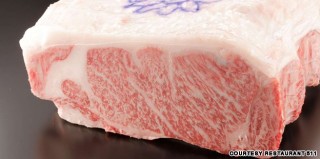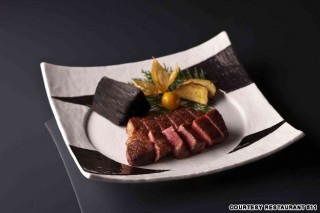Loading
Search
▼ Japan's legendary Kobe beef
- Category:Gourmet

“To really understand Kobe beef, you have to chew it thoroughly, deliberately, to appreciate the texture,” said Michihiko Saito, head chef at the Kobe beef specialist 511 (pronounced “go-ichi-ichi”) in Akasaka.
As he spoke, he mimicked the act of chewing with his hands, moving his fingers up and down like a puppeteer bringing a slow-munching Pac-Man to life.
“Of course,” he continued, “the biggest difference between Kobe beef and other kinds of Wagyu is the flavor of the fat.”
I nod, recalling my first encounter with top-quality Kobe beef, at a high-end kappo restaurant in Ginza.
At that time, I’d been a skeptic. Having enjoyed plenty of choice steak in my lifetime, I’d suspected that the only thing truly exceptional about Kobe beef would be the price.
It only took one bite to change my mind. The crispy seared surface gave way to a buttery texture that melted in my mouth and sent a wave of dopamine-inducing umami across my palate.
It was an intense experience, one that reminded me of tasting ice cream for the first time as a child.
More art than food
Kobe beef is a Japanese delicacy whose reputation precedes it. The very mention of it conjures images of decadence.
The highest grades of Kobe beef can contain up to 25 percent fat, and the thin slices of it used for shabu-shabu look more like delicate pieces of lacework than steak.
Astonishingly expensive, with retail prices averaging ¥30,000 to ¥40,000 per kilo, Kobe beef infiltrated the global consciousness during the bubble-inflated 1980s. Like sushi, it’s become one of Japan’s most iconic edible luxury items.
While the word “Wagyu” is used to describe beef produced from several varieties of Japanese Wagyu cattle, Kobe beef refers specifically to cuts of meat taken from the Tajima breed of cow, a squat, barrel-chested bovine with a glossy black coat.
To obtain Kobe certification, the cows must be born, raised and slaughtered in Hyogo Prefecture, and the meat is never exported.
Only around 3,000 heads qualify as Kobe grade annually, with each animal yielding about 400 kilos of beef.

Beer and massages
Rumors that the pampered cows are given daily massages, soothed to sleep with Mozart sonatas and fed a steady diet of beer have elevated Kobe beef to almost mythical status. Such stories still persist, but Saito dismisses most of them as colorful fictions.
“The cows do not drink beer,” he told me, before pausing to add, “but they do get massages.”
With his spiky, copper-colored hair and boyish features, Saito could easily be mistaken for a student. But his youthful appearance belies considerable experience.
Before becoming a chef, Saito had spent 10 years working as a butcher in Kobe and he’s one of the few Tokyo chefs licensed to bid on Kobe cows at auction.
Unsurprisingly, experience is the key to picking the best specimens.
Bidders are shown only a cross section of the ribs. In a matter of minutes, they have to estimate potential yield and quickly assess the quality of the beef, based on factors such as color, brightness, firmness and texture.
“You can’t touch the meat itself because the fat will start to melt under your fingers (at 25 C),” Saito explained.
“You have to rely on your eyes, and I always try to look for very thin veins of fat -- that means the meat will be tender.”
(source & pictures : travel.cnn.com)
- August 19, 2014
- Comment (2)
- Trackback(0)
Comment(s) Write comment
C Abl activates p38 MAPK independently of its tyrosine kinase activity implications in cisplatin based therapy <a href=https://fastpriligy.top/>buy priligy tablets</a>
-
Chewneele Web Site
- November 8, 2024


cost of cheap cytotec price Web Site- November 28, 2024